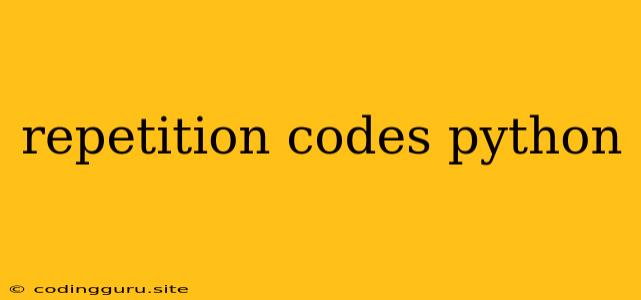Repetition Codes in Python: A Comprehensive Guide
Repetition codes, also known as repetition statements, are a fundamental aspect of programming in Python. They allow you to execute a block of code multiple times, significantly reducing the need to write repetitive lines of code. In this comprehensive guide, we'll explore the key repetition codes in Python, their syntax, and how to effectively utilize them for efficient code development.
What are Repetition Codes?
Repetition codes in Python are control flow statements that enable you to repeat a set of instructions a specified number of times. They are essential for automating tasks, handling data iteratively, and creating dynamic and efficient programs. Python offers two primary repetition codes: for and while loops.
The for Loop: Iterating over Sequences
The for loop is designed for iterating over sequences, such as lists, tuples, strings, and ranges. Its primary purpose is to execute a block of code for each element in the sequence.
Syntax:
for item in sequence:
# Code to be executed for each item
Example:
fruits = ["apple", "banana", "cherry"]
for fruit in fruits:
print(fruit)
This code will print each fruit from the fruits list:
apple
banana
cherry
Key points:
itemrepresents the current element being processed in the loop.sequenceis the collection of items to iterate over.- The loop will execute the code block once for each element in the
sequence.
The while Loop: Repeating until a Condition is Met
The while loop provides a mechanism for repeating a block of code as long as a certain condition remains true.
Syntax:
while condition:
# Code to be executed as long as the condition is True
Example:
count = 0
while count < 5:
print(count)
count += 1
This code will print the numbers from 0 to 4:
0
1
2
3
4
Key points:
conditionis a Boolean expression that determines whether the loop continues.- The loop will execute the code block as long as the
conditionevaluates toTrue. - It's crucial to ensure that the
conditionwill eventually becomeFalseto prevent an infinite loop.
Choosing the Right Loop: for vs. while
Choosing between a for loop and a while loop depends on the specific situation:
- Use a for loop when:
- You need to iterate over a sequence of elements.
- You know exactly how many times the loop should run.
- Use a while loop when:
- You need to repeat a block of code until a certain condition is met.
- You don't know beforehand how many times the loop should run.
break and continue Statements
The break and continue statements provide control over the execution flow within loops:
break: Immediately exits the loop, regardless of the loop condition.continue: Skips the current iteration of the loop and proceeds to the next.
Example:
for i in range(10):
if i == 5:
break
print(i)
# Output:
# 0
# 1
# 2
# 3
# 4
Example:
for i in range(10):
if i % 2 == 0:
continue
print(i)
# Output:
# 1
# 3
# 5
# 7
# 9
Nested Loops
Loops can be nested within other loops, allowing for complex iterative tasks.
Example:
for i in range(3):
for j in range(2):
print(f"i = {i}, j = {j}")
# Output:
# i = 0, j = 0
# i = 0, j = 1
# i = 1, j = 0
# i = 1, j = 1
# i = 2, j = 0
# i = 2, j = 1
Best Practices for Using Repetition Codes
- Clear and Concise Code: Use descriptive variable names and clear comments to enhance code readability.
- Proper Indentation: Python uses indentation to define code blocks within loops.
- Loop Condition Evaluation: Carefully consider the condition that controls loop execution to ensure it will eventually become
False. - Infinite Loop Prevention: Be mindful of infinite loop scenarios and include mechanisms to prevent them.
- Efficiency: Use the most appropriate loop type (for or while) for the task at hand.
Conclusion
Repetition codes are indispensable tools in Python programming, offering the power to automate tasks and simplify complex calculations. By understanding the syntax, purpose, and best practices associated with for and while loops, you can write more efficient, dynamic, and readable Python code. Mastering these core concepts will open the door to a world of possibilities in your programming journey.
